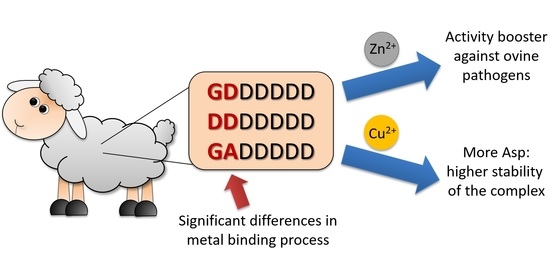Zn-Enhanced Asp-Rich Antimicrobial Peptides: N-Terminal Coordination by Zn(II) and Cu(II), Which Distinguishes Cu(II) Binding to Different Peptides
Abstract
:1. Introduction
2. Results and Discussion
2.1. Mass Spectrometry
2.2. Potentiometric Titration and Spectroscopic Studies
2.2.1. Protonation of the Ligands
2.2.2. Zinc(II) Complexes
2.2.3. Cu(II) Complexes
2.2.4. A Comparison of the Stability of Metal Binding Abilities
2.3. Isothermal Titration Calorimetry
2.4. Membrane Disrupting Ability
2.5. Antimicrobial Activity
3. Materials and Methods
3.1. Mass Spectrometry
3.2. Potentiometry
3.3. Absorption, Circular Dichroism, and Electron Paramagnetic Resonance Spectrometry
3.4. Isothermal Titration Calorimetry
3.5. Liposome Preparation and Leakage Assay
3.6. Antibacterial Activity
4. Conclusions
Supplementary Materials
Author Contributions
Funding
Data Availability Statement
Conflicts of Interest
References
- Koo, H.B.; Seo, J. Antimicrobial peptides under clinical investigation. Pept. Sci. 2019, 111. [Google Scholar] [CrossRef]
- Łoboda, D.; Kozłowski, H.; Rowińska-Żyrek, M. Antimicrobial peptide–metal ion interactions—A potential way of activity enhancement. N. J. Chem. 2018, 42, 7560–7568. [Google Scholar] [CrossRef]
- Wang, G.; Li, X.; Wang, Z. APD3: the antimicrobial peptide database as a tool for research and education. Nucleic Acids Res. 2016, 44, D1087–D1093. [Google Scholar] [CrossRef] [PubMed]
- Brogden, K.A.; de Lucca, A.J.; Bland, J.; Elliott, S. Isolation of an ovine pulmonary surfactant-associated anionic peptide bactericidal for Pasteurella haemolytica. Proc. Natl. Acad. Sci. USA 1996, 93, 412–416. [Google Scholar] [CrossRef]
- Brogden, K.A. Ovine pulmonary surfactant induces killing of Pasteurella haemolytica, Escherichia coli, and Klebsiella pneumoniae by normal serum. Infect. Immun. 1992, 60, 5182–5189. [Google Scholar] [CrossRef]
- Brogden, K.A.; Ackermann, M.; Huttner, K.M. Small, anionic, and charge-neutralizing propeptide fragments of zymogens are antimicrobial. Antimicrob. Agents Chemother. 1997, 41, 1615–1617. [Google Scholar] [CrossRef]
- Chung, E.; Abdullah, F.; Abba, Y.; Tijjani, A.; Sadiq, M.; Mohammed, K.; Osman, A.; Adamu, L.; Lila, M.; Haron, A. Clinical Management of Pneumonic Pasteurellosis in Boer Kids: A Case Report. Int. J. Livest. Res. 2015, 5, 94. [Google Scholar] [CrossRef]
- Besser, T.E.; Frances Cassirer, E.; Highland, M.A.; Wolff, P.; Justice-Allen, A.; Mansfield, K.; Davis, M.A.; Foreyt, W. Bighorn sheep pneumonia: Sorting out the cause of a polymicrobial disease. Prev. Vet. Med. 2013, 108, 85–93. [Google Scholar] [CrossRef]
- Singh, K.; Ritchey, J.W.; Confer, A.W. Mannheimia haemolytica: bacterial-host interactions in bovine pneumonia. Vet. Pathol. 2011, 48, 338–348. [Google Scholar] [CrossRef]
- Heidari, M.; Hamir, A.; Cutlip, R.C.; Brogden, K.A. Antimicrobial anionic peptide binds in vivo to Mannheimia (Pasteurella) haemolytica attached to ovine alveolar epithelium. Int. J. Antimicrob. Agents 2002, 20, 69–72. [Google Scholar] [CrossRef]
- Swaileh, K.M.; Abdulkhaliq, A.; Hussein, R.M.; Matani, M. Distribution of Toxic Metals in Organs of Local Cattle, Sheep, Goat and Poultry from the West Bank, Palestinian Authority. Bull. Environ. Contam. Toxicol. 2009, 83, 265–268. [Google Scholar] [CrossRef]
- Osredkar, J. Copper and Zinc, Biological Role and Significance of Copper/Zinc Imbalance. J. Clin. Toxicol. 2011, s3. [Google Scholar] [CrossRef]
- Hood, M.I.; Skaar, E.P. Nutritional immunity: transition metals at the pathogen-host interface. Nat. Rev. Microbiol. 2012, 10, 525–537. [Google Scholar] [CrossRef]
- Kim, S.Y.; Zhang, F.; Gong, W.; Chen, K.; Xia, K.; Liu, F.; Gross, R.; Wang, J.M.; Linhardt, R.J.; Cotten, M.L. Copper regulates the interactions of antimicrobial piscidin peptides from fish mast cells with formyl peptide receptors and heparin. J. Biol. Chem. 2018, 293, 15381–15396. [Google Scholar] [CrossRef]
- Maisetta, G.; Petruzzelli, R.; Brancatisano, F.L.; Esin, S.; Vitali, A.; Campa, M.; Batoni, G. Antimicrobial activity of human hepcidin 20 and 25 against clinically relevant bacterial strains: effect of copper and acidic pH. Peptides 2010, 31, 1995–2002. [Google Scholar] [CrossRef] [PubMed]
- Gans, P.; Sabatini, A.; Vacca, A. Investigation of equilibria in solution. Determination of equilibrium constants with the HYPERQUAD suite of programs. Talanta 1996, 43, 1739–1753. [Google Scholar] [CrossRef]
- Pettit, L.D.; Gregor, J.E.; Kozlowski, H. Complex formation between metal ions and peptides. Pespectives Bioinorg. Chem. 1991, 1, 1–41. [Google Scholar]
- Peisach, J.; Blumberg, W.E. Structural implications derived from the analysis of electron paramagnetic resonance spectra of natural and artificial copper proteins. Arch. Biochem. Biophys. 1974, 165, 691–708. [Google Scholar] [CrossRef]
- Watly, J.; Simonovsky, E.; Wieczorek, R.; Barbosa, N.; Miller, Y.; Kozlowski, H. Insight into the coordination and the binding sites of Cu2+ by the histidyl-6-tag using experimental and computational tools. Inorg. Chem. 2014, 53, 6675–6683. [Google Scholar] [CrossRef]
- Witkowska, D.; Valensin, D.; Rowinska-Zyrek, M.; Karafova, A.; Kamysz, W.; Kozlowski, H. Coordination of Ni2+ and Cu2+ to metal ion binding domains of E. coli SlyD protein. J. Inorg. Biochem. 2012, 107, 73–81. [Google Scholar] [CrossRef]
- Valensin, D.; Szyrwiel, Ł.; Camponeschi, F.; Rowińska-Zyrek, M.; Molteni, E.; Jankowska, E.; Szymanska, A.; Gaggelli, E.; Valensin, G.; Kozłowski, H. Heteronuclear and homonuclear Cu2+ and Zn2+ complexes with multihistidine peptides based on zebrafish prion-like protein. Inorg. Chem. 2009, 48, 7330–7340. [Google Scholar] [CrossRef]
- Pontecchiani, F.; Simonovsky, E.; Wieczorek, R.; Barbosa, N.; Rowinska-Zyrek, M.; Potocki, S.; Remelli, M.; Miller, Y.; Kozlowski, H. The unusual binding mechanism of Cu(II) ions to the poly-histidyl domain of a peptide found in the venom of an African viper. Dalton Trans. 2014, 43, 16680–16689. [Google Scholar] [CrossRef]
- Witkowska, D.; Rowińska-Żyrek, M. Biophysical approaches for the study of metal-protein interactions. J. Inorg. Biochem. 2019, 199, 110783. [Google Scholar] [CrossRef] [PubMed]
- Wyrzykowski, D.; Pilarski, B.; Jacewicz, D.; Chmurzyński, L. Investigation of metal–buffer interactions using isothermal titration calorimetry. J. Therm. Anal. Calorim. 2013, 111, 1829–1836. [Google Scholar] [CrossRef]
- Johnson, R.A.; Manley, O.M.; Spuches, A.M.; Grossoehme, N.E. Dissecting ITC data of metal ions binding to ligands and proteins. Biochim. Biophys. Acta 2016, 1860, 892–901. [Google Scholar] [CrossRef]
- Uber, D.; Wyrzykowski, D.; Tiberi, C.; Sabatino, G.; Żmudzińska, W.; Chmurzyński, L.; Papini, A.M.; Makowska, J. Conformation-dependent affinity of Cu(II) ions peptide complexes derived from the human Pin1 protein. J. Therm. Anal. Calorim. 2017, 127, 1431–1443. [Google Scholar] [CrossRef]
- Wyrzykowski, D.; Tesmar, A.; Jacewicz, D.; Pranczk, J.; Chmurzyński, L. Zinc(II) complexation by some biologically relevant pH buffers. J. Mol. Recognit. 2014, 27, 722–726. [Google Scholar] [CrossRef]
- Grossoehme, N.E.; Spuches, A.M.; Wilcox, D.E. Application of isothermal titration calorimetry in bioinorganic chemistry. J. Biol. Inorg. Chem. 2010, 15, 1183–1191. [Google Scholar] [CrossRef]
- Makowska, J.; Wyrzykowski, D.; Pilarski, B.; Neubauer, D.; Kamysz, E.; Tesmar, A.; Chmurzyński, L. Copper(II) coordination properties of GxG peptides: Key role of side chains of central residues on coordination of formed systems; combined potentiometric and ITC studies. J. Chem. Thermodyn. 2019, 128, 336–343. [Google Scholar] [CrossRef]
- Migliorini, C.; Witkowska, D.; Valensin, D.; Kamysz, W.; Kozlowski, H. Competition between histamine-like and poly-imidazole coordination sites for Cu2+ and Zn2+ ions in zebra-fish peptide of prion-like protein. Dalton Trans. 2010, 39, 8663–8670. [Google Scholar] [CrossRef]
- Schrodinger LLC. The PyMOL Molecular Graphics System; Schrodinger LLC.: New York, NY, USA, 2010. [Google Scholar]
- Magana, M.; Pushpanathan, M.; Santos, A.L.; Leanse, L.; Fernandez, M.; Ioannidis, A.; Giulianotti, M.A.; Apidianakis, Y.; Bradfute, S.; Ferguson, A.L.; et al. The value of antimicrobial peptides in the age of resistance. Lancet Infect. Dis. 2020, 20, e216–e230. [Google Scholar] [CrossRef]
- Ageitos, J.M.; Sánchez-Pérez, A.; Calo-Mata, P.; Villa, T.G. Antimicrobial peptides (AMPs): Ancient compounds that represent novel weapons in the fight against bacteria. Biochem. Pharmacol. 2017, 133. [Google Scholar] [CrossRef]
- Vizioli, J.; Salzet, M. Antimicrobial peptides from animals: focus on invertebrates. Trends Pharmacol. Sci. 2002, 23, 494–496. [Google Scholar] [CrossRef]
- Brogden, K.A.; Ackermann, M.R.; McCray, P.B.; Huttner, K.M. Differences in the concentrations of small, anionic, antimicrobial peptides in bronchoalveolar lavage fluid and in respiratory epithelia of patients with and without cystic fibrosis. Infect. Immun. 1999, 67, 4256–4259. [Google Scholar] [CrossRef]
- Gran, G.; Dahlenborg, H.; Laurell, S.; Rottenberg, M. Determination of the equivalent point in potentiometric titrations. Acta Che. Scand. 1950, 4, 559–577. [Google Scholar] [CrossRef]
- Gans, P.; O’Sullivan, B. GLEE, a new computer program for glass electrode calibration. Talanta 2000, 51, 33–37. [Google Scholar] [CrossRef]
- Alderighi, L.; Gans, P.; Ienco, A.; Peters, D.; Sabatini, A.; Vacca, A. Hyperquad simulation and speciation (HySS): a utility program for the investigation of equilibria involving soluble and partially soluble species. Coord. Chem. Rev. 1999, 184, 311–318. [Google Scholar] [CrossRef]
- Jimah, J.R.; Schlesinger, P.H.; Tolia, N.H. Liposome Disruption Assay to Examine Lytic Properties of Biomolecules. Bio-Protoc. 2017, 7. [Google Scholar] [CrossRef]
- Kacprzyk, L.; Rydengård, V.; Mörgelin, M.; Davoudi, M.; Pasupuleti, M.; Malmsten, M.; Schmidtchen, A. Antimicrobial activity of histidine-rich peptides is dependent on acidic conditions. Biochim. Biophys. Acta 2007, 1768, 2667–2680. [Google Scholar] [CrossRef]
- International Organization for Standardization (ISO). Susceptibility Testing of Infectious Agents and Evaluation of Performance of Antimicrobial Susceptibility Test Devices—Part 1: Broth Micro-Dilution Reference Method for Testing the In Vitro Activity of Antimicrobial Agents Against Rapidly Growing Aerobic Bacteria Involved in Infectious Diseases; ISO 20776-1:2019; ISO: Geneva, Switzerland, 2019. [Google Scholar]
- International Organization for Standardization (ISO). Clinical Laboratory Testing and In Vitro Diagnostic Test Systems—Reference Method for Testing the In Vitro Activity of Antimicrobial Agents against Yeast Fungi Involved in Infectious Diseases; ISO 16256:2012; ISO: Geneva, Switzerland, 2012. [Google Scholar]
- Gabrielson, J.; Hart, M.; Jarelöv, A.; Kühn, I.; McKenzie, D.; Möllby, R. Evaluation of redox indicators and the use of digital scanners and spectrophotometer for quantification of microbial growth in microplates. J. Microbiol. Methods 2002, 50, 63–73. [Google Scholar] [CrossRef]
- Francisco, F.L.; Saviano, A.M.; Pinto, T.D.J.A.; Lourenço, F.R. Development, optimization and validation of a rapid colorimetric microplate bioassay for neomycin sulfate in pharmaceutical drug products. J. Microbiol. Methods 2014, 103, 104–111. [Google Scholar] [CrossRef] [PubMed]
- The European Committee on Antimicrobial Susceptibility Testing. Breakpoint Tables for Interpretation of MICs and Zone Diameters, 10.0. 2020. Available online: https://www.eucast.org/clinical_breakpoints/ (accessed on 2 June 2021).


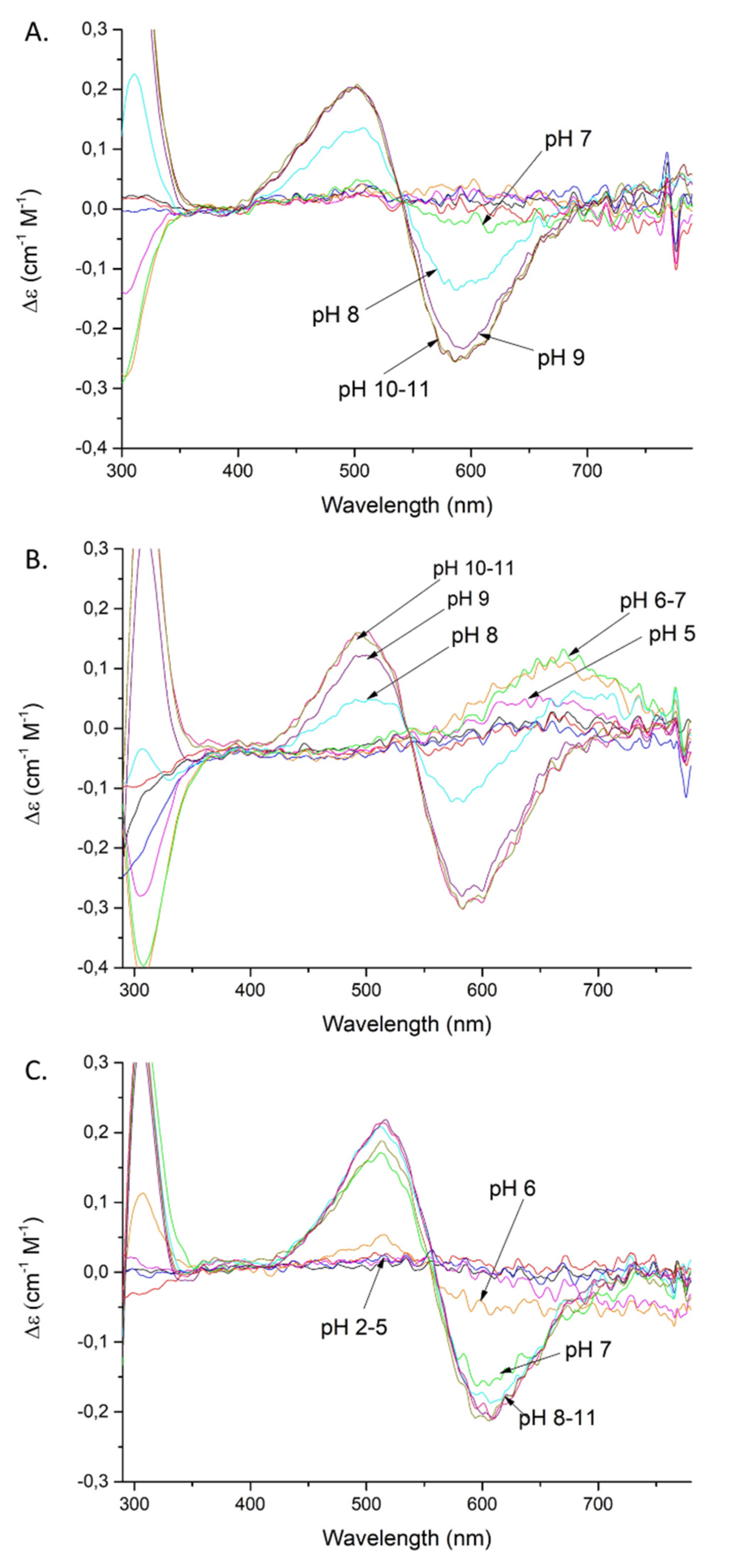


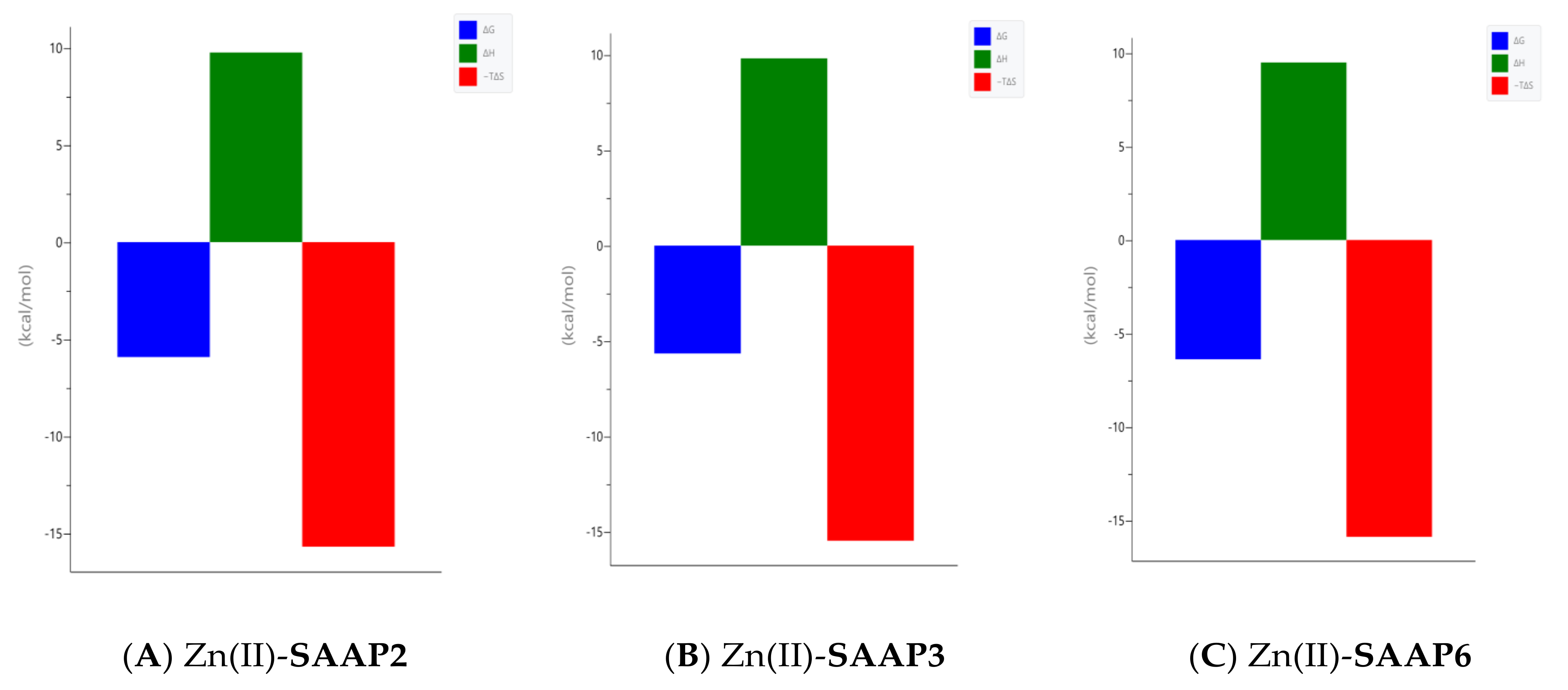

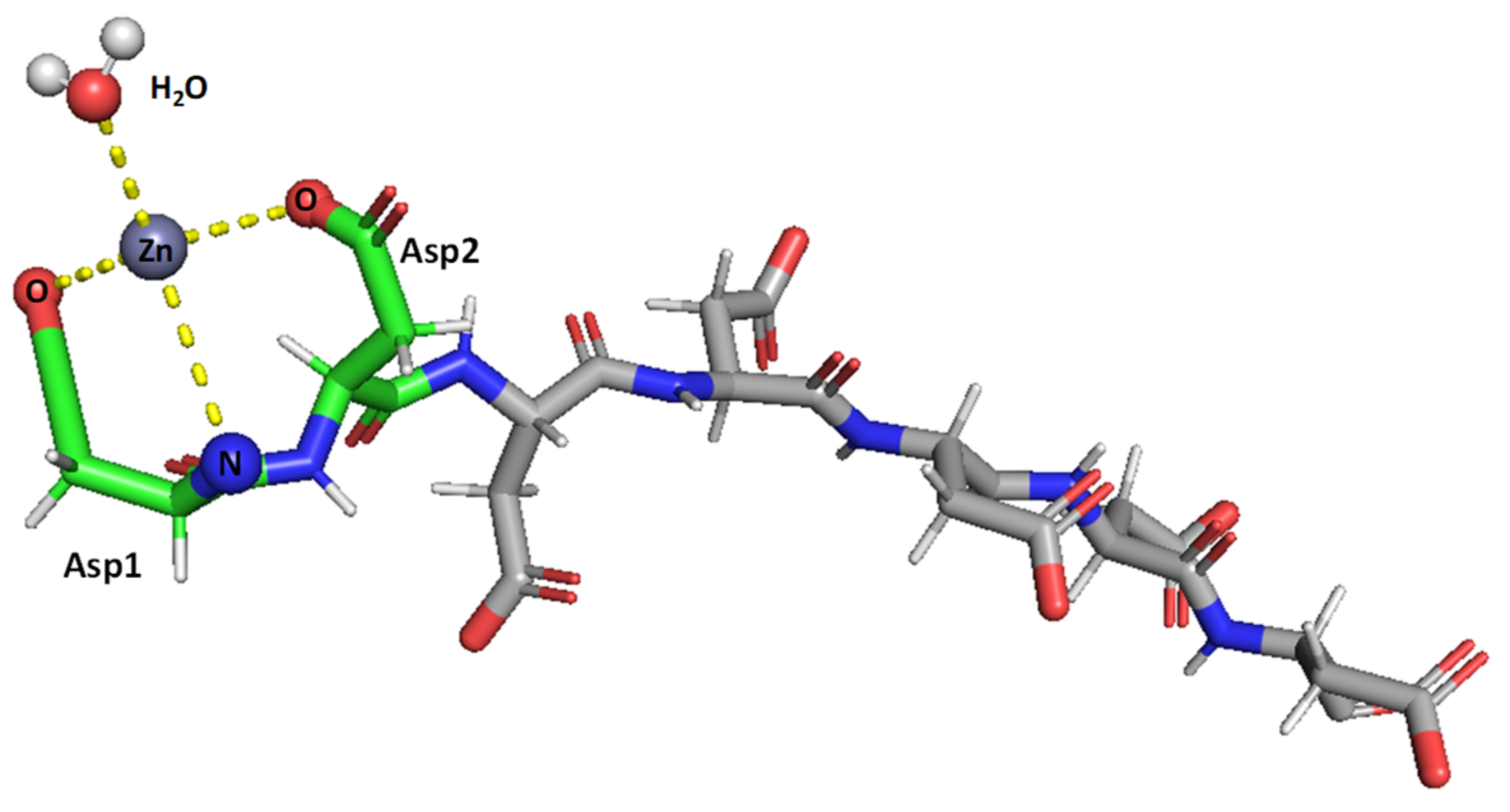
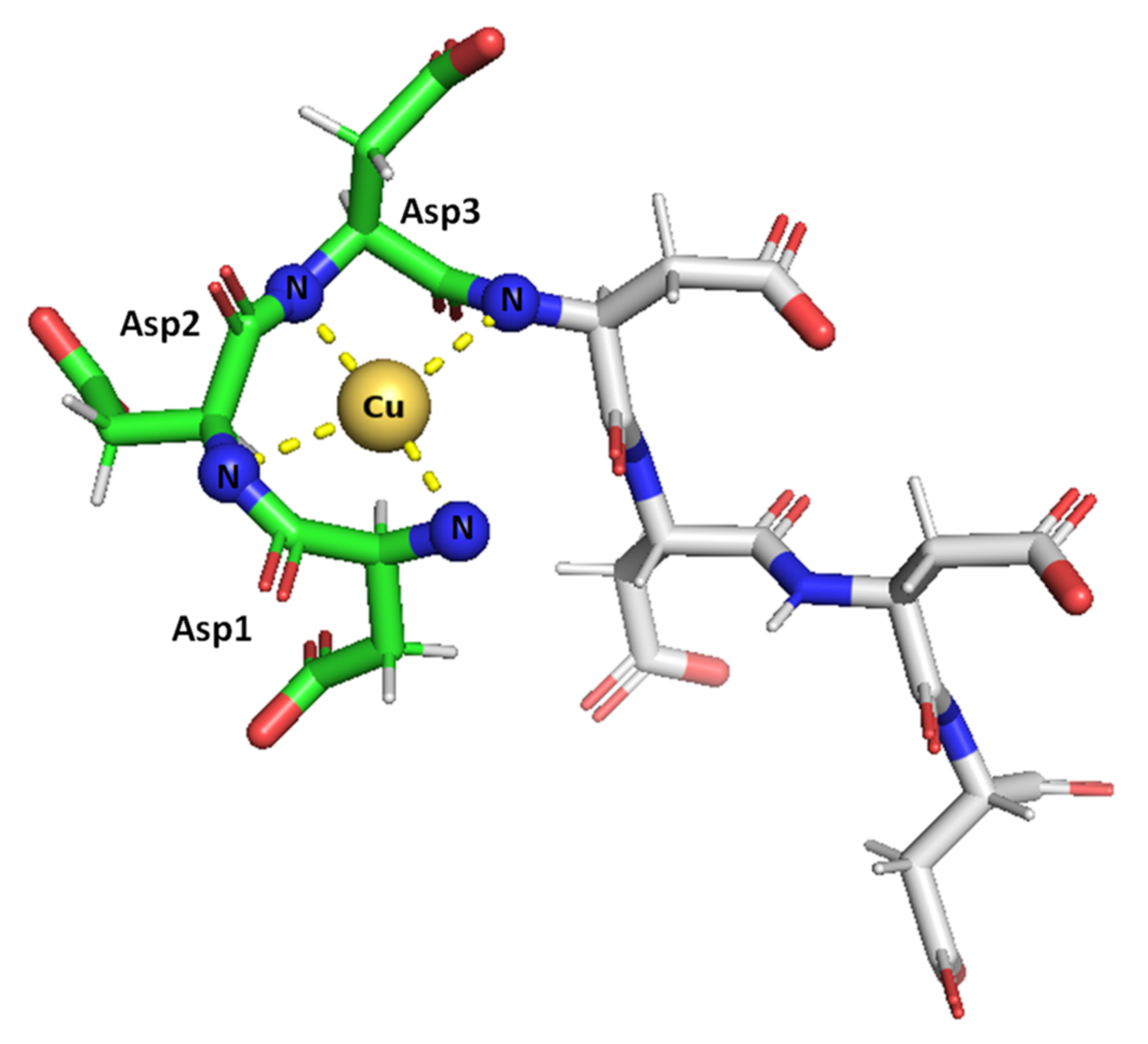
| SAAP2 (GDDDDDD) | SAAP3 (DDDDDDD) | SAAP6 (GADDDDD) | ||||
|---|---|---|---|---|---|---|
| species | logβ | logK | logβ | logK | logβ | logK |
| LH | 8.74 (4) | 8.74 (N-t) | 8.43 (2) | 8.43 (N-t) | 8.70 (1) | 8.70 (N-t) |
| LH2 | 14.30 (8) | 5.56 (Asp) | 14.32 (4) | 5.89 (Asp) | 14.26 (3) | 5.56 (Asp) |
| LH3 | 18.99 (8) | 4.69 (Asp) | 19.30 (3) | 4.98 (Asp) | 18.96 (2) | 4.70 (Asp) |
| LH4 | 23.27 (10) | 4.28 (Asp) | 23.89 (4) | 4.59 (Asp) | 23.19 (3) | 4.23 (Asp) |
| LH5 | 26.89 (10) | 3.62 (Asp) | 28.02 (3) | 4.13 (Asp) | 26.73 (2) | 3.54 (Asp) |
| LH6 | 29.89 (12) | 3.00 (Asp) | 31.52 (4) | 3.50 (Asp) | 29.70 (2) | 2.97 (Asp) |
| LH7 | 34.72 (3) | 3.20 (Asp) | ||||
| Zn(II) complexes | ||||||
| ZnH3L | 22.49 (4) | |||||
| ZnH2L | 17.44 (4) | 17.84 (3) | 4.65 (Asp) | |||
| ZnHL | 12.58 (2) | 4.86 (Asp) | 12.92 (2) | 4.92 (Asp) | 12.15 (4) | |
| ZnL | 6.27 (3) | 6.31 (N-t) | 6.38 (2) | 6.54 (N-t) | 6.10 (3) | 6.05 (N-t) |
| ZnH−1L | −1.97 (3) | 8.24 (H2O) | −1.96 (2) | 8.34 (H2O) | −1.91 (4) | 8.01 (H2O) |
| ZnH−2L | −10.91 (3) | 8.94 (H2O) | −10.74 (2) | 8.78 (H2O) | −10.86 (4) | 8.95 (H2O) |
| ZnH−3L | −20.26 (3) | 9.35 (H2O) | −19.88 (2) | 9.14 (H2O) | −20.21 (4) | 9.35 (H2O) |
| Cu(II) complexes | ||||||
| CuH5L | 31.68 (3) | |||||
| CuH4L | 26.19 (5) | - | 26.53 (7) | |||
| CuH3L | - | 24.40 (2) | - | |||
| CuH2L | 18.81 (2) | 19.87 (3) | 4.53 (Asp) | 18.75 (5) | ||
| CuHL | 14.09 (3) | 4.72 (Asp) | 15.46 (3) | 4.41 (Asp) | 13.92 (5) | 4.83 (Asp) |
| CuL | 9.22 (2) | 4.87 (Asp) | 10.13 (4) | 5.33 (Asp) | 8.56 (6) | 5.36 (Asp) |
| CuH−1L | 3.20 (2) | 6.02 (amide) | 4.23 (5) | 5.90 (amide) | 2.03 (6) | 6.53 (amide) |
| CuH−2L | −4.12 (3) | 7.32 (amide) | −3.47 (7) | 7.70 (amide) | −4.45 (8) | 6.48 (amide) |
| CuH−3L | −13.59 (4) | 9.47 (amide) | −12.89 (10) | 9.42 (amide) | −14.49 (12) | 10.04 (amide) |
| Cu(II)-SAAP2 | Cu(II)-SAAP3 | Cu(II)-SAAP6 | ||||||||||
|---|---|---|---|---|---|---|---|---|---|---|---|---|
| A‖ [G] (Azz) | g‖ (gz) | g⊥ (gx = gy) | MW Frequency [GHz] | A‖ [G] (Azz) | g‖ (gz) | g⊥ (gx = gy) | MW Frequency [GHz] | A‖ [G] (Azz) | g‖ (gz) | g⊥ (gx = gy) | MW Frequency [GHz] | |
| 3 | 121.3 | 2.412 | 2.080 | 9.5788 | 121.4 | 2.418 | 2.080 | 9.5735 | 121.3 | 2.410 | 2.080 | 9.5873 |
| 4 | 140.6 | 2.370 | 2.070 | 9.5884 | 140.4 | 2.370 | 2.065 | 9.5758 | 141.7 | 2.364 | 2.074 | 9.5884 |
| 5 | 140.0 | 2.365 | 2.071 | 9.5857 | 140.0 | 2.367 | 2.065 | 9.5793 | 137.5 | 2.364 | 2.065 | 9.5857 |
| 6.5 | 133.5 | 2.372 | 2.056 | 9.5878 | 131.5 | 2.375 | 2.062 | 9.5778 | 133.5 | 2.371 | 2.056 | 9.5878 |
| 180.0 | 2.251 | 2.055 | 180.0 | 2.258 | 2.050 | 200.0 | 2.202 | 2.045 | ||||
| 7.5 | 179.0 | 2.252 | 2.050 | 9.5827 | 182.0 | 2.247 | 2.047 | 9.5784 | 200.0 | 2.201 | 2.043 | 9.5832 |
| 9 | 200.2 | 2.205 | 2.040 | 9.5802 | 206.0 | 2.201 | 2.045 | 9.5741 | 204.3 | 2.202 | 2.043 | 9.5840 |
| 10 | 200.2 | 2.205 | 2.040 | 9.5762 | 206.0 | 2.201 | 2.045 | 9.5778 | 204.3 | 2.202 | 2.045 | 9.5888 |
| Ligand | KdITC [M] | ΔHITC [kcal/mol] | -TΔSITC [kcal/mol] | nITC |
|---|---|---|---|---|
| Binding to Zn(II) (pH 7.4) | ||||
| SAAP2 | (32 ± 2) × 10−6 | 8.7 ± 0.2 | −14.8 | 0.92 ± 0.01 |
| SAAP3 | (35 ± 2) × 10−6 | 7.6 ± 0.2 | −13.7 | 0.96 ± 0.01 |
| SAAP6 | (18.1 ± 0.6) × 10−6 | 9.4 ± 0.1 | −15.9 | 1.05 ± 0.01 |
| Binding to Cu(II) (pH 6.8) | ||||
| SAAP2 (r) | (1.6 ± 0.2) × 10−6 | 4.6 ± 0.1 | −12.5 | 1.20 ± 0.01 |
| SAAP3 (r) | (0.31 ± 0.06) × 10−6 | 4.2 ± 0.1 | −13.0 | 1.29 ± 0.01 |
| SAAP6 (r) | (1.9 ± 0.3) × 10−6 | 7.2 ± 0.2 | −15.0 | 1.02 ± 0.01 |
| SAAP6 (f) | (2.2 ± 0.2) × 10−6 | 6.0 ± 0.1 | −13.7 | 0.61 ± 0.01 |
Publisher’s Note: MDPI stays neutral with regard to jurisdictional claims in published maps and institutional affiliations. |
© 2021 by the authors. Licensee MDPI, Basel, Switzerland. This article is an open access article distributed under the terms and conditions of the Creative Commons Attribution (CC BY) license (https://creativecommons.org/licenses/by/4.0/).
Share and Cite
Miller, A.; Matera-Witkiewicz, A.; Mikołajczyk, A.; Wątły, J.; Wilcox, D.; Witkowska, D.; Rowińska-Żyrek, M. Zn-Enhanced Asp-Rich Antimicrobial Peptides: N-Terminal Coordination by Zn(II) and Cu(II), Which Distinguishes Cu(II) Binding to Different Peptides. Int. J. Mol. Sci. 2021, 22, 6971. https://doi.org/10.3390/ijms22136971
Miller A, Matera-Witkiewicz A, Mikołajczyk A, Wątły J, Wilcox D, Witkowska D, Rowińska-Żyrek M. Zn-Enhanced Asp-Rich Antimicrobial Peptides: N-Terminal Coordination by Zn(II) and Cu(II), Which Distinguishes Cu(II) Binding to Different Peptides. International Journal of Molecular Sciences. 2021; 22(13):6971. https://doi.org/10.3390/ijms22136971
Chicago/Turabian StyleMiller, Adriana, Agnieszka Matera-Witkiewicz, Aleksandra Mikołajczyk, Joanna Wątły, Dean Wilcox, Danuta Witkowska, and Magdalena Rowińska-Żyrek. 2021. "Zn-Enhanced Asp-Rich Antimicrobial Peptides: N-Terminal Coordination by Zn(II) and Cu(II), Which Distinguishes Cu(II) Binding to Different Peptides" International Journal of Molecular Sciences 22, no. 13: 6971. https://doi.org/10.3390/ijms22136971
APA StyleMiller, A., Matera-Witkiewicz, A., Mikołajczyk, A., Wątły, J., Wilcox, D., Witkowska, D., & Rowińska-Żyrek, M. (2021). Zn-Enhanced Asp-Rich Antimicrobial Peptides: N-Terminal Coordination by Zn(II) and Cu(II), Which Distinguishes Cu(II) Binding to Different Peptides. International Journal of Molecular Sciences, 22(13), 6971. https://doi.org/10.3390/ijms22136971





